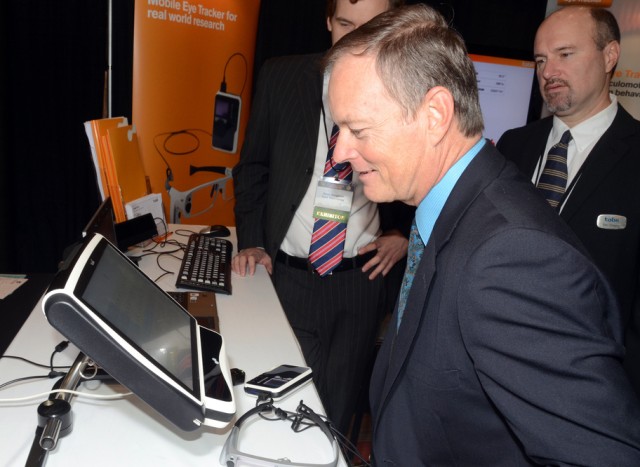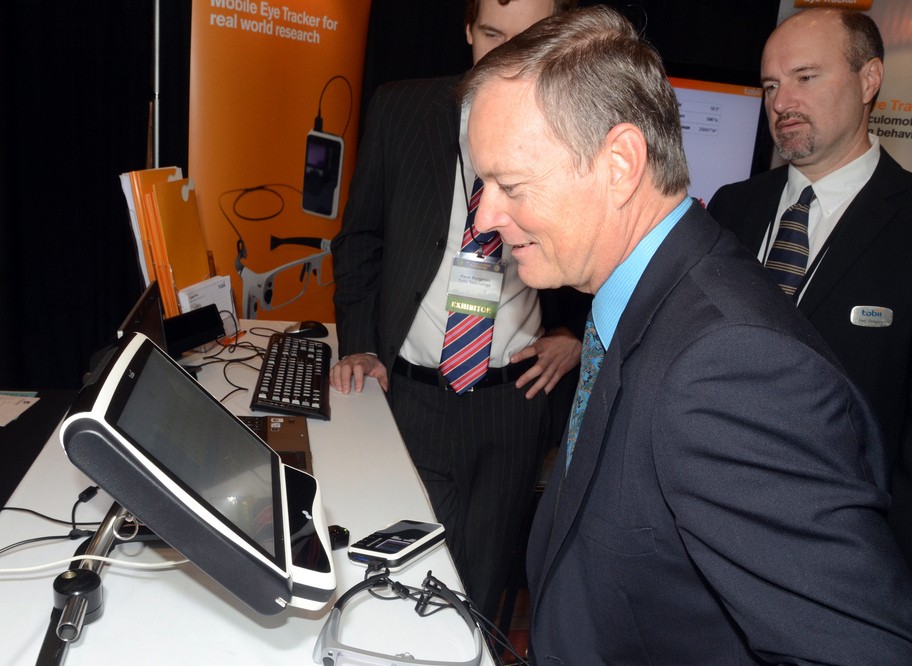WASHINGTON (Army News Service, Jan. 24, 2011) -- The Army's new chief scientist is already immersed in a range of scientific activities to include research into suicide prevention, air and ground-based unmanned systems, Soldier protective gear and precision munitions, among others.
Appointed to his new post in October, Scott Fish signed on after spending several years as the director and deputy director of the Institute for Advanced Technology at the University of Texas, Austin -- one of the Army's premier research partners.
"This is a fantastic job with a great group of people," Fish said with enthusiasm. "One of my primary responsibilities is to maintain a broad technical perspective -- to be able to reach across our broad portfolio and bring that broad knowledge to our senior leaders in supporting their decisions. Maintaining a network of experts with our technical community is a key element of being a good chief scientist."
Fish arrives with a wealth of research, academic, industry and military experience. Prior to his post at the University of Texas, he served as a program manager at the Defense Advanced Research Project Agency, assistant vice president for technology at Science Applications International Corp., and as naval architect and systems engineer with the Naval Surface Warfare Center.
One of Fish's key, high-priority initial assignments has been to collaborate with scientists and mental health professionals to ensure maximum benefit in research investments needed to promote health and reduce suicides within the Army and across the services.
"The vice chief of staff (Gen. Peter Chiarelli) published a major study last July on this topic, and I've been asked to take a look at how we prioritize and evaluate research within this area and recommend improvements to the existing research governance methods," he said. "This look reaches across the services and DoD and so far, I'm finding that the Army medical and mental health research communities have taken this need very seriously."
Fish is also sharply focused on technologies which improve protection for forces and serve to better develop the Soldier as a decisive weapon in battle.
"Certainly Soldier protection is a key element. Beyond improvements in the traditional body armor, there may be novel ways of protecting the Soldier with equipment in their proximity," Fish said.
"We are looking at concepts for Soldiers as they operate in small units and how they can collectively provide protection to one another. There are a lot of innovative folks getting the message that ensuring our Soldiers continue to be a decisive weapon is a priority spearheaded by Doctor O'Neill (Assistant Secretary of the Army for Acquisition, Logistics and Technology Malcolm Ross O'Neill)," he added.
Fish is also busy analyzing the latest trends in unmanned technology with the goal of leveraging scientific advances to bring new capability to Soldiers; this includes a thorough examination of cutting-edge algorithms designed to increase autonomy of ground robots and Unmanned Aircraft Systems.
Advances in science have made it possible to demonstrate unmanned prototypes able to transport cargo, search for explosives and track enemy targets - while needing little or no human intervention or tele-operation, Fish explained. Some versions of these systems are getting limited use in theater, to show benefits beyond the thousands of tele-operated robots Soldiers are using already in Iraq and Afghanistan.
"We want to increase autonomy both to reduce Soldier workload as well as network communication load. The more autonomous decisions made local to individual sensors and mobile platforms - the less video and other high-volume data we need to move around with radios," Fish said.
"There are many algorithms which have shown benefits in these areas. We need to push this technology quickly to allow our Soldiers to reap the physical security benefits of remote-intelligent assistants on the battlefield and within our logistical system," he said. "I'm talking with autonomy researchers across the government, industry and academia to ensure we're leveraging innovative work in this area for both near and far-term military benefits."
With these issues in mind, Fish met with his Air Force counterpart and will soon link up with the Navy experts in this field to identify possibilities for more inter-service collaboration.
"The chief scientist of the Air Force is very interested in potential areas for collaboration," Fish said. "The Army and Air Force both have unmanned air systems collecting reconnaissance data. The use of common data analysis, related to what we use for autonomous driving or flying, to sift through the data, could highlight areas of high interest and augment human interpretation."
With respect to Autonomous Navigation Systems or ANS that is now being developed for ground robots, Fish said the Army will continue to leverage the latest technological advances.
"There's a lot of terrific research being conducted by companies and universities out there -- that should help us achieve greater cost savings while continuously improving performance."
On the munitions front, Fish praised the technology of the Army's new Enhanced Performance Round (M855A1) - a more capable, lead-free 5.56mm ammunition round.
"The 855A1 is fantastic, and the development and acquisition team has done a terrific job of getting from idea through validation and fielding. We will certainly be looking at next-generation techniques and we will also be looking at how we migrate these new technologies to other rounds," he said.


Social Sharing